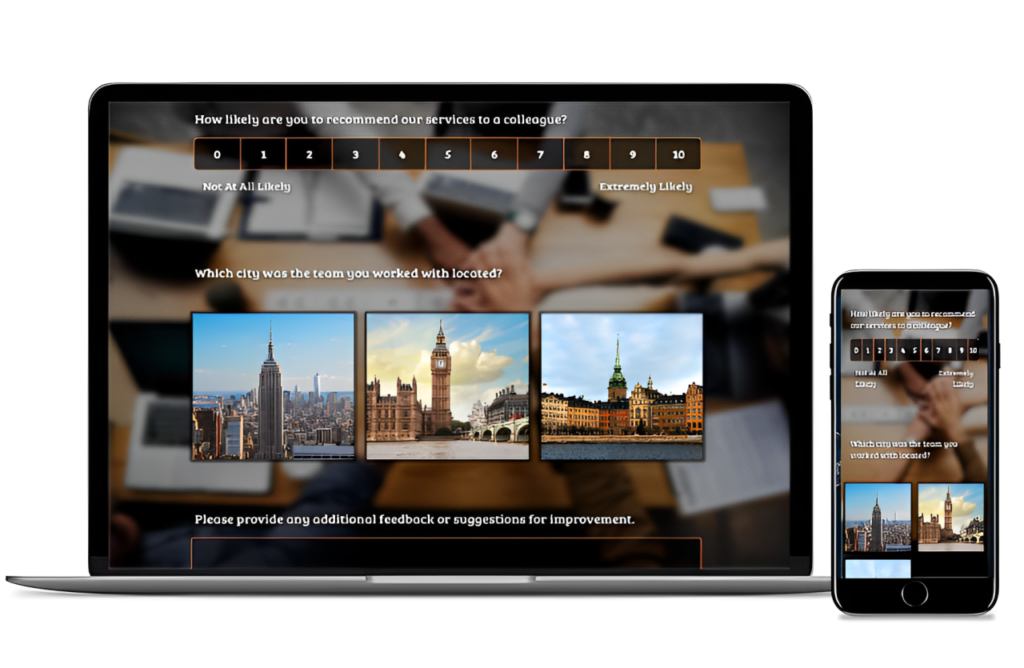We’ve talked a lot about the customer experience in the past – but what about the product experience? While customer experience may be king, product experience is just as important as it determines how valuable a consumer thinks that your product or service is. This perception will determine whether they buy again from you, talk up your brand to others, and so on. So, it’s important to find out what you can through a product feedback survey.
Create your product experience survey, questionnaire, or form now!
What is Product Experience?
Product experience, or PX, is defined as: “the awareness of the psychological effects elicited by the interaction with a product, including the degree to which our senses are stimulated, the meanings and values we attach to the product, and the feelings and emotions that are elicited.”
If that leaves you scratching your head, no worries – we’re going to dive into what it all means in a moment!
Product Experience vs. Customer Experience: What’s the Difference?
It’s not uncommon for the terms product experience and customer experience to be used interchangeably, however, they are very different. Customer experience, or CX, consists of everything from the customer’s first interaction with a company to their last. It defines how the company meets customer expectations throughout various touchpoints in the relationship, such as:
- Interacting with a website
- Reacting to marketing or advertising
- Speaking with customer service
- Placing an order
- Shipping and delivery
- Quality of product
- Follow-up support/returns
So, as you can see, product experience is a branch of customer experience. While CX considers every touchpoint in a customer/business relationship, PX focuses solely on how the product or service delivers making product experience management integral to any company.
3 Main Components of Product Experience
There are three main components of the customer experience that any company should strive to excel at. We’ve summed them up before, but for an in-depth look at each, check out the International Journal of Design article here.
Aesthetic Experience
Aesthetics refers to a product’s ability to delight a person’s senses. It may be pleasing to look at, make a pleasant sound, smell good, or feel nice to the touch. While these sensory feelings are important, they generally don’t have as much of an impact as the emotional level.
Experience of Meaning
At this level, the product appeals to someone because they assign a high value to it. This often occurs when a product is considered luxurious or coveted by others. When a person is able to attain the product, it provides them with a feeling of confidence, independence, and achievement.
Emotional Experience
Last but not least is the emotional experience. This is when a product generates emotion – not usually because of the product itself, but because of the personal significance of it. For example, a smartphone consumer may experience joy because they can easily connect with friends, while a first-time car buyer may experience excitement because of their newfound mobility.
7 Reasons to Conduct Product Experience Surveys
In a previous blog, we discussed the reasons why it’s important to conduct customer experience surveys. However, it’s also important to conduct product experience surveys. You’ll often find product satisfaction survey questions centered around the following seven topics.
1. Product Testing & Design
Product testing is important in the early stages of development, to be sure there’s a market for your product and that consumers like both it and its design. It’s also important later on, to ensure that consumers remain satisfied or if they approve of any new features or updates made to the product design. All of this contributes to the aesthetic experience.
2. Product Naming
Because a name may elicit an emotional response from someone (good or bad), in the early stages of product development you may want to get input from consumers. It may sound unnecessary, but did you know that Google was originally called “Backrub”? That didn’t last long!
3. Product Positioning
Is your product one-of-a-kind, or are you in a competitive space? Will your offer personalization, or is each product identical? These can impact a consumer’s experience of meaning. With a product experience survey focused on product positioning, you can determine what a customer is looking for in regards to your product in order to better brand your item or service.
4. Product Pricing
During product development, you will want to get a gauge on how much people are willing to pay for your product. After its release, you’ll want to survey them again to find out if they feel they got their money’s worth. Pricing is a big factor when it comes to the experience of meaning component of PX. For example, a high-priced luxury brand is likely to give people a sense of success if they’re able to afford it.
5. Product Packaging
Packaging doesn’t just protect a product, it promotes it! Therefore, it’s important to find out what consumers think of your packaging and what kind of response they have to it (this hits on all three PX components). The right packaging could encourage purchase, while the wrong packaging could turn someone away. Check out some eye-opening stats about packaging here.
6. Product Performance
Did your product perform up to expectations? (Better yet, did it exceed them?) It’s important to be sure your product performs well, and consistently, over time. If a product fails to deliver, a customer may have a negative experience of meaning or a poor emotional experience.
7. Product Intuitiveness/Instruction
Some products – say, a cereal brand – don’t have to be intuitive (everyone knows what to do with it). However, the more complicated a product becomes, the more intuitive consumers expect it to be. Even if it’s a complex product, detailed instruction should make it easy to understand or customers may have a negative emotional reaction.
15 Product Feedback Questions You Should Ask
The type of questions you ask on your product experience survey will vary greatly depending on the product and what you want to know. Here are a few product feedback survey questions to get you started!
- What do you like most about our product?
- Is there anything you don’t like about our product?
- How often do you use our product?
- What features on our product are most valuable to you?
- Are there features on our product we’re missing/that’d you’d like to see?
- Do you find the packaging of our product appealing?
- Are you proud to use/own our product?
- How would you compare our products to our competitors’?
- What are you trying to solve by using our product?
- Which types of people could find our product useful?
- Did you find it easy to use our product?
- How would you rate the value for money?
- Would you purchase another product from us in the future?
- How likely are you to recommend this product to others?
- What could we do to improve our product to better meet your needs?
Conclusion
As a part of the customer experience, the product experience remains extremely important. Even if you provide the best service, the fastest shipping, and the most desirable brand, if the product experience is poor, that can all be ruined. One way to say on top of things is through product experience surveys. You can easily create them on SurveyLegend using our pre-designed, responsive, and secure templates. Get started today!
What does your company do to provide a great product experience? Any product satisfaction survey questions you think we should add to our starter list? Let us know in the comments below!
Create your product experience survey, questionnaire, or form now!
Frequently Asked Questions (FAQs)
Product experience is how a customer reacts to a good or service due to its aesthetics, desirability, and any emotions it may prompt.
A customer experience encompasses every interaction a person has with a company, from seeing their advertisement to talking with a representative. A product experience is related solely to their interaction with the product or service itself.
A product experience survey can help marketers and researchers understand what it is about their product that appeals (or doesn’t appeal) to consumers.





